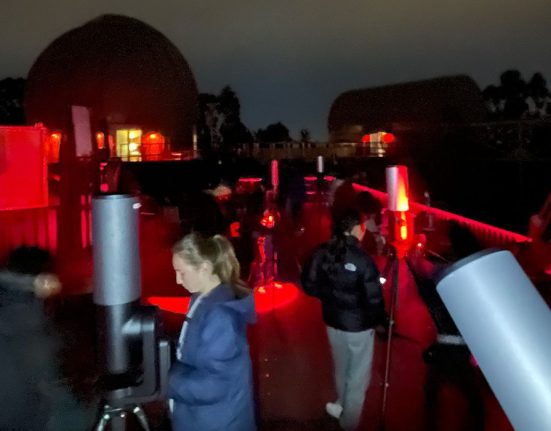
Bob Rey
I have been a dedicated visual observer since I was 11 years old. I enjoy observing the night sky with the naked eye or through a telescope. The photons traveling millions of light years and finding a home in the biology of my eye, my brain, and my consciousness make me feel like I am physically interacting with the larger cosmos. The thrill this gives me is hard to describe, but I keep trying.
In addition to visual observing, I have also been involved in astrophotography from the beginning. By age 12 I was already looking for a camera capable of doing long exposures; my first camera from Walgreens was not up to the task. Since then, photography has been an integral part of exploring the night. I enjoy including local landscapes when photographing conjunctions, naked-eye comets, auroras, eclipses, and meteor showers.

Bob Rey
During and since the pandemic, members of our two regional astronomy clubs, the Arrowhead Astronomical Society and Chippewa Valley Astronomical Societyhave met weekly on Zoom to share images and stories. Last year, one of the members mentioned smart telescopes and the potential they could have to revolutionize amateur astronomy. It seemed like everyone was buying one and posting amazing images on social media sites. A smart telescope has a built-in camera that accumulates successive short exposures of a selected target until it creates a detailed image. The user operates it with a smartphone, and the photos are stored in the phone’s photo library. No knowledge of the sky is required, and a beginner can start using it in minutes.

Bob Rey
My first reaction was mild despair. It seemed like more and more beginners to the hobby were skipping the sky-learning part in favor of flashy images taken with automated telescopes. At the same time, I realized that this knee-jerk reaction was short-sighted. The proliferation of light pollution coupled with the inherent challenges faced by novices in finding astronomical objects have made visual astronomy increasingly difficult in recent years. Inexpensive, automated astrophotography offers yet another avenue to reach the stars, and the more options there are, the more likely a person is to find something that suits their needs.

Bob Rey
Plus, let’s be honest, most of us are buried in our phones. An astronomical activity that includes the device is likely to generate more interest than more traditional methods. Smart telescopes produce surprisingly clear and deep images for their small apertures, and with the right software, anyone can capture and display professional-looking photographs for personal enjoyment or to share on social media. To see what all the hype was about, I spent $499 on a Seestar S50 last winter. I also justified the expense as a quick and easy way to record my favorite transient phenomena, like supernovae and comets.

Bob Rey
After some initial focusing and aiming issues, I've had many great sessions this spring and early summer photographing transient phenomena and, just for fun, a sprinkling of galaxies, nebulas, and star clusters. “Blown away” describes exactly how I felt watching photos merge on my smartphone screen in near real time. It brought me back to my old darkroom days, when I'd watch an image magically appear on a blank sheet of photo paper. In the blink of an eye, galaxies grow arms, comets throw out tails, and faint nebulas reveal delicate shades of color. The experience is both magical and alluring.

Bob Rey
While this particular smart camera lacks the resolution of a dedicated astrophotography rig, the results are detailed and impressive. Users can let images accumulate for hours if needed. The unit even has a built-in dew heater for humid nights and a nebular filter to enhance emission nebulas. As soon as the exposure is complete, the images are uploaded to your phone. Later, I move them to my main computer to edit them in Photoshop, then use Visual Paradigm’s free program. Online Image Enhancer to remove grain and noise. The final results are as seen here. Other users prefer more robust astrophotography software, such as Siril (free) or Pix's Perspective.
Smartscopes are becoming more and more popular. In addition to ZWO Seestar, companies like Single star, Vaonis, Celestronand Dwarf Laboratory They sell a variety of models at different price points. Currently, only Unistellar offers a direct channel for citizen scientists to share images and data with professional astronomers. The smart telescopes are well-suited to work on “exoplanet transits, asteroid occultations, and near-Earth object modeling,” says Matthew Ryno, 39, vice president and interim president of the Milwaukee Astronomical SocietyThe club has two eVscopes that are used constantly by members of all ages, including some as young as 14.

Glenn Sarlitto
“Telescopes connect you directly to researchers so you can contribute to science from your backyard,” Ryno said. Unistellar partners with the SETI Institute to disseminate information about targets. Users upload their data to Unistellar's servers, which are used by Scientists from the SETI InstituteClub members have participated “in more than 350 scientific missions,” Ryno said, and have seen their names and data published in multiple papers.
“I post their light curves on the observatory wall,” Ryno said.
With all the Seestars out there, driven by a lively Facebook GroupIt would be great if ZWO would step up and offer its army of users a similar citizen science option. Easy astrophotography combined with a dedicated data pipeline would motivate many to make a scientific contribution.
I am optimistic that newbies approaching astronomy for the first time with a smart telescope will find a path to cosmic discovery and enjoyment as others have done in more traditional ways. Likewise, veteran observers who have never considered trying their hand at astrophotography or contributing to a scientific paper now have a door wide open.








Leave feedback about this